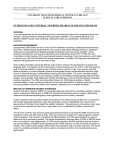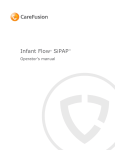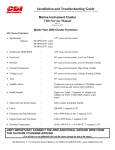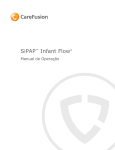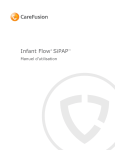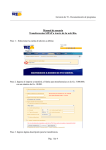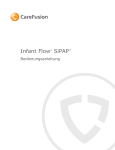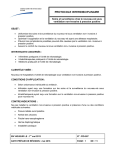Download Infant Flow® SiPAP Plus user guide
Transcript
Infant Flow SiPAP Plus user guide ® Table of contents Section 1: Circuit setup.................................. 1 Open bed or crib and isolette.......................... 2 Abdominal sensor........................................... 3 Pressure nomogram for Infant Flow LP system................................. 4 Alarm test....................................................5-6 Two point oxygen calibration.......................7-8 Disable oxygen sensor..................................... 9 Startup menu and leak test......................10-11 Section 2: Operation.................................... 12 Soft key operation...................................13-14 Operation modes.......................................... 15 Alarm Set/Confirm screen............................. 16 Mode Select screen....................................... 17 Parameter Adjust screen............................... 18 Incompatible settings............................... 19 Main screen.................................................. 20 Monitored Parameter screen......................... 21 Alarm management...................................... 22 Final check and routine inspection................ 23 Troubleshooting............................................ 24 Notes............................................................ 25 i Section 1: Circuit setup WARNING: • Do not attach generator to patient until verification and Infant Flow SiPAP NCPAP/ Pres Low L/min initial setup are complete Pres High L/min 14 50 12 10 8 60 5 70 40 80 21 100 90 30 4 3 6 4 2 2 1 CAUTION: XDCR • Follow manufacturer’s instructions for setup and operation of humidifier OPTIONAL: • Use transducer interface for Apnea and Low Breath Rate alarm, and BiPhasic Tr mode (Intl only) 1 PPROX Open bed or crib Isolette Use extension tube with isolette. Remove extension tube if excessive condensation occurs. 2 Abdominal sensor placement 1. Connect transducer to driver. 2. Connect respiratory sensor to transducer. 3. Compress the sensor gently; LED on the transducer illuminates. 4. Apply the sensor to the infant: a. Pressure line perpendicular to tape. b. Place between the umbilicus and xiphisternum. c. Alternative placement—the side of the abdomen. 5. Verify correct placement. Transducer LED illuminates on expiration, and front panel LED on inspiration. OPTIONAL: • Use transducer interface for Apnea and Low Breath Rate alarm, and BiPhasic Tr mode (Intl only) 3 Pressure Nomogram for Infant Flow system The Infant Flow SiPAP system is subject to a direct relationship between the controlled gas flow and airway pressure. For example, 8 to 9 LPM gas flow provides approximately 5 cmH2O. 15.0 13.0 11.0 9.0 (cmH2O) 7.0 5.0 3.0 1.0 4.0 6.0 8.0 10.0 (LPM) 4 12.0 14.0 16.0 18.0 Alarm test WARNING: Alarm test initial settings Prior to patient application, ensure that all User Verification testing and calibration procedures are successfully completed. User Verification testing and calibration procedures must be done off patient. Air supply > 30 psig (2.1 bar) N/A High nCPAP/Press low 9 LPM 1. Connect air and oxygen gas supply. Connect power cord to AC outlet. Attach patient circuit, generator and patient interface. Occlude the opening to the patient. %O2 30% Press high flow 3 LPM Mode nCPAP 2. Power up the driver and allow Power On Check to complete. 3. From nCPAP mode, with alarms set, remove occlusion from opening to patient. Low pressure alarm activates. Restore the occlusion and rest the alarms. 5 Infant Flow LP generator/circuit Use settings below for step 9 Rate 30 bpm Ti 0.3 sec Apnea/LBR interval 20 sec Alarm test (continued) 4. Adjust the nCPAP/Pres Low flow meter to 11 LPM. The high airway pressure alarm activates. Decrease flow to 8 LPM. Reset the alarms. 5. Adjust the %O2 control to 35%. The High %O2 alarm activates. Return the O2 setting to 30%. Reset alarms. 6. Adjust the %O2 to 25%. The Low %O2 alarm activates. Return the O2 setting to 30%. Reset the alarms. 7. Disconnect the AC power cord from the wall outlet. The Loss AC alarm activates. Reconnect the AC power cord. Reset alarms. 8. Occlude exhalation line and increase nCPAP pressure to 11 cmH2O. The High Circuit Pressure alarm activates. Decrease flow to 8 LPM and reset alarms. 9. Select and confirm BiPhasic mode. Change the mandatory rate control setting to 1. Low Breath rate alarm activates after the default interval of 20 seconds. Return to rate of 30. Reset the alarms. 6 Two point oxygen calibration 1. Adjust flow meters and turn on driver. 2. Press the calibration (CAL) button in the Setup screen. 3. Adjust the Oxygen Control to 21%: a. Allow reading to stabilize. b. Press the flashing button to confirm. c. A check mark appears and %O2 display should read 21%. 4. Adjust the Oxygen Control to 100%: a. Allow reading to stabilize. b. Press the flashing button to confirm. c. A check mark appears and %O2 display should read 21%. 5.Press Exit button. 7 Two point oxygen calibration (continued) NOTE: • If calibration fails, a red “X” is displayed, the alarm sounds and an Error code is displayed; repeat the calibration procedure • Two point calibrations are required with initial setup and circuit changes 8 Disable oxygen sensor Disable O2 button 1.From Setup screen, press the calibration (CAL) button. 2. Press the O2 Disable button: a. Oxygen monitoring and the audible oxygen alarms are disabled. b. Error Code 55 is displayed. 3. Use an external oxygen analyzer to monitor FiO2. WARNING • Always use an external oxygen monitor if the oxygen sensor is disabled. 9 Startup menu and leak test 1. Connect prong or mask to generator; occlude opening to patient. 2. Set nCPAP flow to 9 LPM and High flow to 3 LPM. 3. Turn on the driver. 4. Verify measured pressure is 5 ±1%. If less than 5 cmH2O is displayed check for leaks. 5. Touch flashing icon to confirm. 6. Adjust O2% dial to desired setting. Verify measured value is within +/- 3%. 7. Touch flashing icon to confirm. 10 Startup menu and leak test (continued) 8. Adjust press High flow as desired. 9. Touch flashing icon to confirm. 10. Connect transducer assembly to the traducer interface connector on the front of the Infant Flow SiPAP, if desired. Touch flashing icon to confirm. 11.Touch NCPAP or Alarm Mute/Reset button to set alarms. 12. Measured CPAP should be 5 cmH2O. If not, check for leaks. 13. Remove occlusion to prongs or mask. Measured CPAP should drop to 0 to 2 cmH2O. If not, check for occlusions. 11 Section 2: Operation A.Power LED A C B B.Alarm warning bar XDCR C.Transducer interface LED D.LCD touch screen D E.%O2 control F. Press high flow meter Infant Flow® SiPAP G.Connection proximal pressure line NCPAP/ H.Transducer interface connection L/min I. Circuit connection inspiratory limb J. nCPAP/pres low flow meter Press High Press Low L/min 40 30 J 21 50 60 70 80 90 E 100 F I H G XDCR 12 PPROX Soft key operation Description Example A button that is enabled. A button that is inhibited due to non-availability of the designated feature or pending acknowledgement of an active alarm condition. A selected mode or control pending confirmation is visually highlighted and intermittently flashes between yellow and white text. While a button is pressed, the edges are highlighted to provide a pressed appearance. 13 Soft key operation (continued) Description Example When there is an active alarm associated with a measured value, the measured value concerned is displayed with RED FLASHING text. The associated limit value (if any) is displayed in RED. When an alarm that is associated with a measured value is resolved, the device remains in a LOW priority alarm state, with the measured value displayed in YELLOW FLASHING text and the associated limit displayed in YELLOW, until the alarms are cleared by the operator. Manual breath delivers a Biphasic cycle at current settings for T-High, Press High and %O2. Only one BiPhasic cycle is delivered regardless of button press duration. If no screen interactions occur for a period of 120 seconds and there are no active alarms, the screen goes to a “locked” state to prevent inadvertent entries. To unlock the screen, press the lock icon. 14 Operational modes CPAP is a constant single level of positive pressure to the infant’s airway, facilitating the restoration of functional residual capacity and correction of hypoxemia. BiPhasic is two levels of pressures, delivered at a set Time High (T-High) criteria, rate and pressure settings. Small incremental pressure increases of 2 to 3 cmH2O augment functional residual capacity and may off load work of breathing. Low breath rate (LBR) detection is via a respiratory abdominal sensor. The LBR alarm will be triggered when the set time interval is exceeded. If the infant’s breath is detected within the next time out period, the alarm will silence. 15 Alarm set/confirm screen 1.Touch the nCPAP or Alarm button for 3 seconds to set the alarm limits. If neither button is not touched within 2 minutes, the alarm limits will automatically be set. 2.The screen will change to Mode Select screen with the driver operating in nCPAP mode. 16 Mode Select screen 1.Press the desired mode button. The display will change to the Parameter Adjust screen. NOTE: • Only the available modes will be displayed on the menu bar 1. • For Low Breath Rate (LBR) modes, attach the transducer assembly and respiratory abdominal sensor 17 Parameter Adjust screen 1.Press the desired parameter button to change. Only the relevant controls are visible. The selected parameter and associated numeric display are highlighted. 2.Use the up and down arrow buttons to adjust the setting. 3.Confirm the change by pressing the parameter button. If no action is taken, the new parameter will take effect after 15 seconds. NOTE: • Parameter changes can be made during initial setup and normal operation 18 Incompatible settings • When one parameter (A) change is incompatible with another parameter (B), the software will automatically make an adjustment to that parameter (B) • If the adjusted parameter (A) is restored in less than 15 seconds, the parameter (B) change is reversed • When parameter adjustments cause a reduction in another parameter to maintain requirements for minimum breath interval, the reduced parameter is displayed in RED for 15 seconds EXAMPLE: • BiPhasic mode with T-High = 2.0 seconds: As rate is increased above 28 breaths per minute, the constraint on minimum T-Low requires a reduction in T-High. If rate is increased to 29, then T-High will automatically reduce to 1.9 seconds. If rate is reduced back to 28 within 15 seconds, the previous T-High setting (2.0 sec) is restored. NOTE: • T-High automatically reduces to maintain a minimum T-Low of 100 milliseconds. 19 Main screen • The Main screen displays current mode of operation alarm status, battery charge status, monitored parameters and pressure time graphic display • Only the active parameters for the selected mode are available for adjustment • Press the Change Screen button to access the Monitored Parameter screen 20 Monitored Parameter screen 1. The Monitored Parameter screen displays measured values and parameter settings for all BiPhasic modes. 2. Active parameters are available for adjustment. 3.Press the Change Screen button to return to the Main screen. 21 Alarm management Audible alarm priority • High priority: A series of 10 tones every 10 seconds, flashing red • Medium priority: Three audible tones every 15 seconds, flashing yellow • Low priority: Two audible tones every 30 seconds, solid yellow Silencing audible alarms Pressing the Alarm Reset button will silence active alarms for up to 30 seconds. A new high priority alarm condition will cancel the alarm silence. Resetting alarms Press the Alarm Reset button for 3 seconds to clear resolved and low priority alarm and to rest alarm limits. 22 Final check and routine inspection Inspect the system at least every 3 to 4 hours to: • Ensure the patient is receiving the prescribed level of CPAP • Ensure the generator is stable, secure and not pulling upward on the nose • Check for deformation or irritation to the nose or surrounding tissue • Ensure the patient’s septum is clearly visible when using prongs • Ensure the patient’s eyes are clearly visible and the nares are not blocked, when using masks • Inspect the fixation device and straps for proper tension and adjust as needed to maintain a proper fit • Monitor the patient for gastric insufflation and abdominal distension • Monitor for excessive condensation in circuit and generator 23 Troubleshooting Alarm Priority Possible cause Potential actions %O2 < 18% High O2 CAL required Reset FiO2 above limit, O2 CAL %O2 < 104% High O2 CAL required Reset FiO2 below limit, O2 CAL High %O2 High %O2 setting changed, supply gas failure, water trap overflow Correct FiO2, reset alarm limits Low %O2 High Blender setting changed, supply gas failure, water trap overflow Correct FiO2, reset alarm limits Over pressure High Flow Rate set too high, occlusion of exhalation limb, blocked silencer/filter Check exhaust tube/filter, reduce flow rate, reset alarm limits Low battery Warning Battery charge status change Connect to AC Low battery voltage Medium Battery disconnect, fails to hold charge Connect to AC Loss AC High AC power disconnected Connect to AC High nCPAP/ Press Low High Setting change, circuit disconnect Reset alarm limits Low nCPAP/ Press Low High Setting change, circuit disconnect, leak Reset alarm limits, check for leaks High BiPhasic pressure High Press High setting change, circuit disconnect Reset alarm limits 24 Notes 25 WARNING—U.S. Federal Law restricts this device to sale by or on the order of a physician. CareFusion 22745 Savi Ranch Parkway Yorba Linda, CA 92887 800.231.2466 toll-free 714.283.2228 tel 714.283.8493 fax carefusion.com © 2012 CareFusion Corporation or one of its subsidiaries. All rights reserved. Infant Flow, CareFusion and the CareFusion logo are trademarks or registered trademarks of CareFusion Corporation or one of its subsidiaries. RC767 (0912/2000) L3429 Rev. B




























